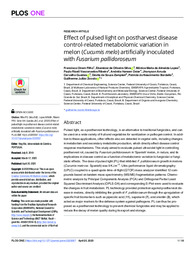Effect of pulsed light on postharvest disease control-related metabolomic variation in melon (Cucumis melo) artificially inoculated with Fusarium pallidoroseum.
Effect of pulsed light on postharvest disease control-related metabolomic variation in melon (Cucumis melo) artificially inoculated with Fusarium pallidoroseum.
Author(s): OIRAM FILHO, F.; SILVA, E. de O.; LOPES, M. M. de A.; RIBEIRO, P. R. V.; OSTER, A. H.; GUEDES, J. A. C.; ZAMPIERI, D. de S.; BORDALLO, P. do N.; ZOCOLO, G. J.
Publication year: 2020
Types of publication: Journal article
Keywords: Biomarcadores, Biomarkers, Cucumis Melo, Doenças fúngicas, Fruits, Fungal diseases, Fungal pathogens, Fusarium pallidoroseum, Light pulses, Melons, Melão, Metabolites, Metabolitos, Patógenos fúngicos, Plant resistance to abiotic stress, Pulsos de luz, Resistência das plantas ao estresse abiótico
Observation
Some of Embrapa's publications are published as ePub files. To read them, use or download one of the following free software options to your computer or mobile device. Android: Google Play Books; IOS: iBooks; Windows and Linux: Calibre.
Access other publications
Access the Agricultural Research Database (BDPA) to consult Embrapa's full library collection and records.
Visit Embrapa Bookstore to purchase books and other publications sold by Embrapa.

